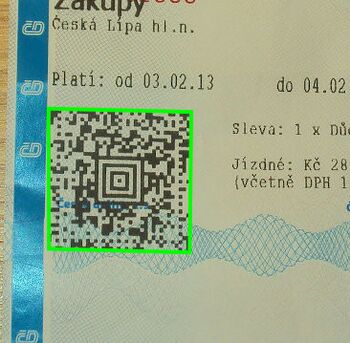Difference between revisions of "Example Detect Aztec Code"
From BoofCV
Jump to navigationJump to search (Created page with "<center> <gallery widths=807px heights=331px> File:Example_aztec_code_scan.jpg | Aztec Code marker detected on a ticket. </gallery> </center> [https://en.wikipedia.org/wiki/A...") |
m |
||
| (One intermediate revision by the same user not shown) | |||
| Line 1: | Line 1: | ||
<center> | <center> | ||
<gallery widths= | <gallery widths=350px heights=350px> | ||
File:Example_aztec_code_scan.jpg | Aztec Code marker detected on a ticket. | File:Example_aztec_code_scan.jpg | Aztec Code marker detected on a ticket. | ||
</gallery> | </gallery> | ||
| Line 15: | Line 15: | ||
Relevant Examples/Tutorials: | Relevant Examples/Tutorials: | ||
* [https://www.ninox360.com/barcode-scanner 2D Barcode Webapp] | |||
* [[Example_Render_Aztec_Code|Rendering Aztec Codes]] | * [[Example_Render_Aztec_Code|Rendering Aztec Codes]] | ||
* [[Example_Detect_QR_Code|QR Codes]] | * [[Example_Detect_QR_Code|QR Codes]] | ||
Latest revision as of 08:49, 10 November 2022
Aztec Codes are popular in transportation and related industries. They can encode a lot of information and don't require a quite zone around the marker. However, due to the lack of easily identified landmarks, larger markers are harder to scan.
Example Code:
Concepts:
- Fiducials
- QR Codes
Relevant Examples/Tutorials:
Example Code
/**
* Shows you how to detect an Aztec Code inside an image. BoofCV provides a lot of information about the marker and
* provides an accurate location of the finder pattern. For example, you can get the number of bit errors which
* were encountered while reading and will return failed detections with the reason they failed.
*
* @author Peter Abeles
*/
public class ExampleDetectAztecCode {
public static void main( String[] args ) {
BufferedImage input = UtilImageIO.loadImageNotNull(UtilIO.pathExample("fiducial/aztec/image01.jpg"));
GrayU8 gray = ConvertBufferedImage.convertFrom(input, (GrayU8)null);
var config = new ConfigAztecCode();
// config.considerTransposed = false; // by default, it will consider incorrectly encoded markers. Faster if false
AztecCodePreciseDetector<GrayU8> detector = FactoryFiducial.aztec(config, GrayU8.class);
detector.process(gray);
// Gets a list of all the qr codes it could successfully detect and decode
List<AztecCode> detections = detector.getDetections();
// Print the encoded messages
for (AztecCode marker : detections) {
System.out.println("message: '" + marker.message + "'");
}
// Visualize the found markers in the image
Graphics2D g2 = input.createGraphics();
int strokeWidth = Math.max(4, input.getWidth()/200); // in large images the line can be too thin
g2.setColor(Color.GREEN);
g2.setStroke(new BasicStroke(strokeWidth));
for (AztecCode marker : detections) {
VisualizeShapes.drawPolygon(marker.bounds, true, 1, g2);
}
// List of objects it thinks might be a QR Code but failed for various reasons
List<AztecCode> failures = detector.getFailures();
g2.setColor(Color.RED);
for (AztecCode marker : failures) {
// If it failed to decode the mode then there's a decent change of it being a false negative
if (marker.failure.ordinal() < AztecCode.Failure.MODE_ECC.ordinal())
continue;
VisualizeShapes.drawPolygon(marker.bounds, true, 1, g2);
}
ShowImages.showWindow(input, "Example Aztec Codes", true);
}
}
